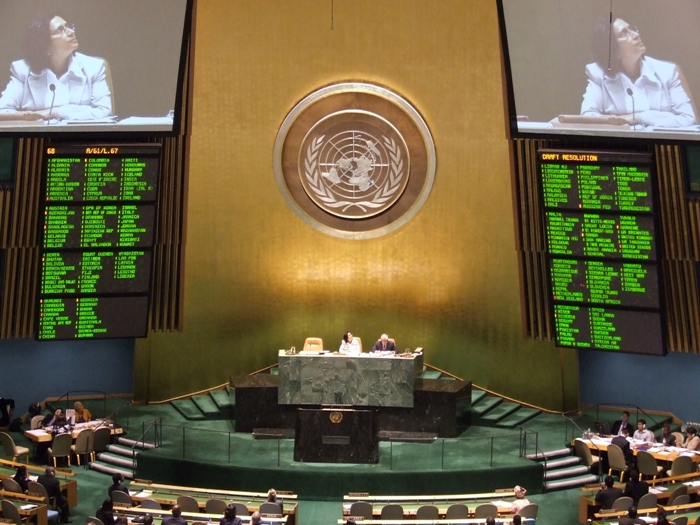

The UN votes to adopt the Declaration on the Rights of Indigenous Peoples, Sep. 13, 2007. Photo: Stefan Disko.
The United Nations Declaration on the Rights of Indigenous Peoples is the most comprehensive international human rights instrument to specifically address Indigenous Peoples’ economic, social, cultural, political, civil, spiritual and environmental rights. In its own words, the Declaration sets out minimum standards necessary for the “dignity, survival and well-being” of Indigenous Peoples.
The UN General Assembly overwhelmingly adopted the Declaration on 13 September 2007. This historic adoption followed more than 20 years of deliberation and debate in which Indigenous Peoples worked directly with states to elaborate upon and advance their human rights.
The Declaration affirms the inherent or pre-existing collective human rights of Indigenous Peoples, as well as the human rights of Indigenous individuals. It provides a framework for justice and reconciliation, applying existing human rights standards to the specific historical, cultural and social circumstances of Indigenous Peoples.
>
“The tragic and brutal story of what happened to us, especially at the hands of the governments, is well known. …But today, with the adoption of the Declaration on the Rights of Indigenous Peoples by the United Nations General Assembly, we see the opportunity for a new beginning, for another kind of relationship with States in North America and indeed throughout the world.”
Ten Facts on the Declaration


Grand Chief Wilton Littlechild at the United Nations Permanent Forum on Indigenous Issues, 2017
-
The Declaration was adopted by a vote of the overwhelming majority of the UN General Assembly.
-
The only four states that voted against the Declaration have all reversed their positions and endorsed the Declaration.
-
The Declaration affirms collective rights of Indigenous Nations or Peoples and the individual rights of Indigenous persons.
-
All rights in the Declaration are inherent: governments cannot give or take away these rights.
-
All governments have a responsibility to respect, protect and fulfill these rights.
-
The Declaration builds on decades of expert interpretation of existing international human rights laws and standards. It does not create new rights.
-
International human rights declarations have diverse legal effects.
-
Canadian courts and Tribunals have already applied the Declaration in the interpretation of Canadian law.
-
Indigenous Peoples’ representatives worked for more than two decades to achieve the Declaration. It is the first international instrument where the rights holders themselves participated equally with states in the drafting.
-
The Declaration constitutes a principled framework for justice, reconciliation, healing and peace.